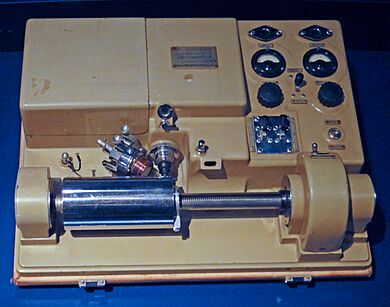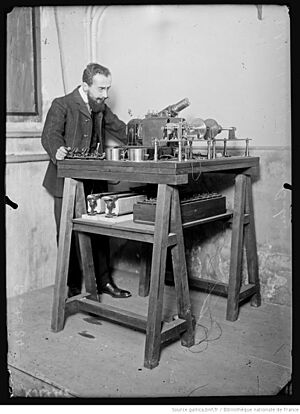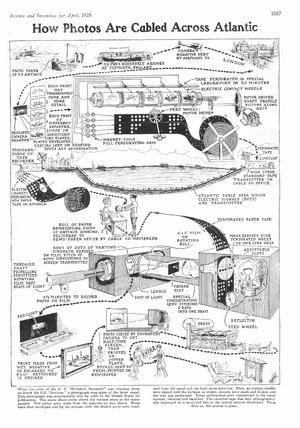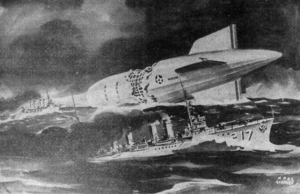Wirephoto facts for kids

Belinograph BEP2V wirephoto machine by Édouard Belin, 1930
|
|
| Process type | Physical, analogue |
|---|---|
| Industrial sector(s) | Wire service, photojournalism |
| Main technologies or sub-processes | Telegraph, telephone, photography |
| Product(s) | Fax, photography |
| Leading companies | Western Union, AT&T, Associated Press, others |
| Year of invention | 1920s |
Imagine sending a picture across the country or even the world in just minutes! That's what Wirephoto (also known as telephotography or radiophoto) made possible. It was a groundbreaking technology that allowed people to send photographs using telegraph, telephone, or radio signals. Before Wirephoto, sharing pictures over long distances was slow and difficult. This invention changed how news was reported and how people saw events happening far away.
Contents
The History of Sending Pictures
Before Wirephoto, there were earlier attempts to send pictures electronically. One of the first was the Telediagraph, invented by Ernest A. Hummel in 1895. This machine could send simple images over special electrical lines. It connected major newspapers like the New York Herald and the Chicago Times Herald, allowing them to share pictures faster than ever before.
A big step forward came in 1913 with the Bélinographe, created by Édouard Belin. His machine used a special light sensor, called a photocell, to scan pictures. What was really clever about it was that it could send these scanned images over regular phone lines. In Europe, services similar to a wirephoto were often called "Belino" after him.
In 1920, the Bartlane system was developed by Harry G. Bartholomew and Maynard D. McFarlane. This system was special because it could turn pictures into digital information. This digital data was then sent across the Transatlantic telegraph cable between London and New York. The first picture was sent across the Atlantic using this method in 1921.
Soon, major companies started using this new technology. Western Union sent its first photograph in 1921. AT&T joined in 1924, and RCA began sending pictures using radio waves, calling them Radiophotos, in 1926.
Early wirephoto machines were quite slow, and the pictures weren't always very clear. But in 1929, an engineer named Vladimir Zworykin created a much better system. His invention made pictures look clearer and could send a whole page in about one minute. This was a huge improvement!
Wirephoto Goes Mainstream
By the 1930s, wirephoto machines were still big and costly. They needed special phone lines just for sending pictures. News organizations, like the Associated Press, had to rent these expensive lines. This led to a race to create smaller, more affordable machines. The goal was to send photos over regular phone lines, making the technology available to more people.
The Associated Press (AP) launched its own Wirephoto service in 1935. They even had a special trademark for "AP Wirephoto" for many years. The very first photo they sent by wire showed a small plane crash in New York's Adirondack Mountains in December 1934. This showed how quickly news could now travel with pictures.
Just a few months later, in February 1935, the U.S. Navy airship USS (ZRS-5) crashed into the Pacific Ocean. The AP Wirephoto service sent its first drawing related to this event. It was a sketch by artist Noel Sickles showing the crash and the search for survivors. At first, some thought only photos should be sent. However, a picture of the Macon survivors was quickly sent from San Francisco to New York City using a new machine. This meant newspapers could publish the photo the very next morning. By 1936, portable wirephoto machines were available. These could be carried anywhere and used regular long-distance phone lines, making it even easier to send news photos.
Wirephoto During Important Events
Wirephoto technology was also important during major historical events. Near the end of World War II, for example, radiophotos were used to help with communication. Images of messages meant for leaflets were sent from Honolulu to Saipan. These images helped the printing presses on Saipan create the leaflets quickly.
After World War II, wirephoto even played a role in the fashion world! In Paris, at haute couture (high fashion) shows, a person named Frederick L. Milton would quickly sketch new runway designs. He would then send these sketches using a Bélinographe to his clients. This allowed them to see and copy the latest Parisian fashions very quickly. In 1955, some famous French designers, like Dior and Lanvin, felt this was unfair. They argued that the speed of wirephoto transmission hurt their businesses because their unique designs were copied too fast. This led to a legal dispute in New York.
See also
- Frederick Bakewell
- Alexander Bain (inventor)
- Giovanni Caselli
- Bain's facsimile
- Fax
- Hellschreiber
- Pantelegraph
- Slow-scan television




